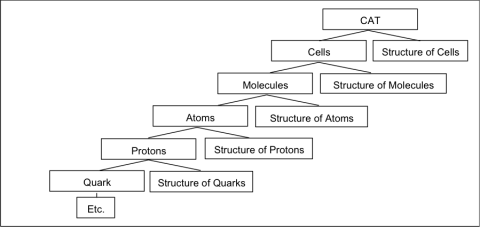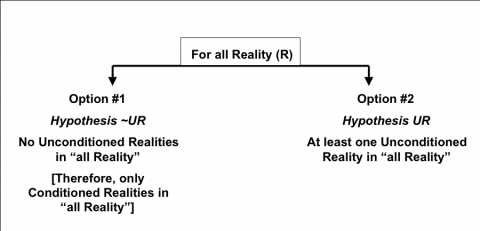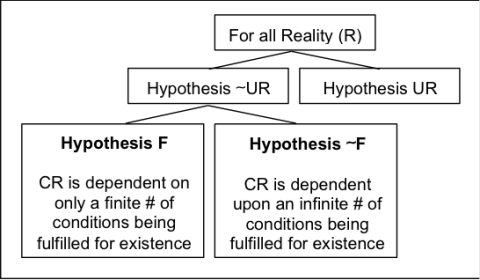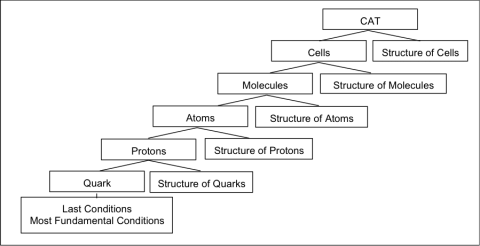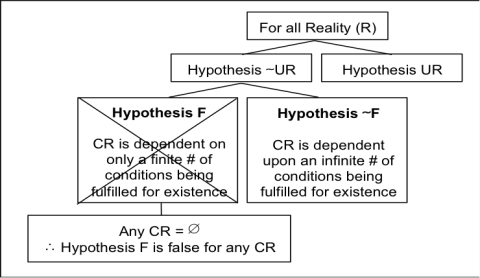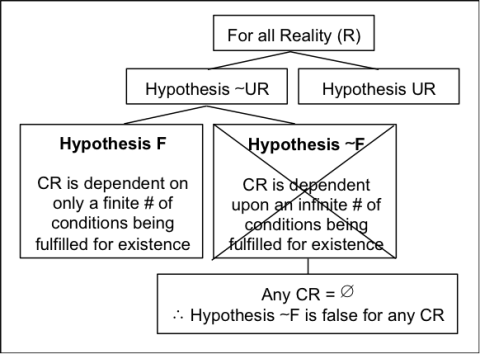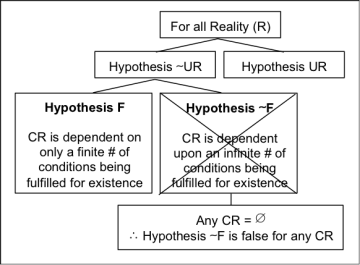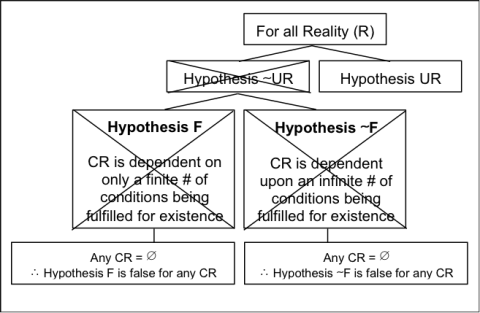Metaphysical Proofs
The Magis God Wiki: Metaphysical Proofs
Can the Existence of God be Logically Proven?
© Robert J. Spitzer, S.J./Magis Institute July 2011 – All rights reserved
The following unit gives a brief synopsis of the three kinds of publicly accessible evidence used for rational proof or disproof (Section I) and the first step in a logical-metaphysical proof for the existence of God (Section II). The latter gives only the first step in that proof (there must exist at least one unconditioned reality). The other steps of the proof which show that there can be only one unconditioned reality, and that this unique reality is absolutely simple, unrestricted, and the continuous Creator of all else that is may be found in NPEG Chapter Three and also in lectures # 6 through 11 of PID.[1]
Contents
- 1 Three Kinds of Publicly Accessible Evidence for Rational Proof
- 2 A Logical-Metaphysical Proof for the Existence of God
- 2.1 Metaphysical Proof for the Existence of God
- 2.1.1 Proof of the Existence of at Least One Unconditioned Reality
- 2.1.2 Proof that an unconditioned reality must be absolutely simple.
- 2.1.3 Proof that an absolutely simple reality must be absolutely unique (one and only one).
- 2.1.4 Proof that the one absolutely simple unconditioned reality must also be unrestricted in its power or act.
- 2.1.5 Proof that the One Unconditioned Reality is the Continuous Creator of All Else that Is
- 2.1 Metaphysical Proof for the Existence of God
- 3 Footnotes
Three Kinds of Publicly Accessible Evidence for Rational Proof
It might do well to begin with a brief summary of the three methods of assuring publicly accessible evidence: a-posteriori, a-priori, and a combination of both (contradiction of a fact). Two-thousand, four-hundred years ago, Aristotle showed that all human knowledge is based on certain first principles which are necessary for the functioning of any proof, and therefore cannot be proved (or disproved) without themselves being used. He implied that it was reasonable to believe in the validity of these first principles since they had shown themselves to be reliable in countless individual circumstances, and responsible to believe in them because their denial would require a virtual cessation to thought.[2]
A belief may be considered reasonable and responsible if:
1) it can be affirmed by rigorous public corroboration, or
2) its denial leads to an intrinsic contradiction, or
3) its denial leads to a contradiction of publicly corroborated fact.
One of these forms of evidence is sufficient to ground the truth of a proposition. More than one would provide additional corroboration, but is not necessary. Standards for the reasonable and responsible definition of terms will be given below.
With respect to (1), rigorous corroboration means an agreed upon criterion for corroboration which is sufficient to make a preponderance of reasonable and responsible people believe that a denial of the claim is far more unreasonable and irresponsible than an affirmation of it. In the domain of sense description (e.g., Bob Spitzer is coming into his office) this corroboration could occur through agreement on sensorial apparitions from multiple persons having multiple perspectives. In science, rigorous corroboration could occur through different kinds of experimentation, repetitions of experiments, different kinds of measuring devices, etc. In social sciences, this might come from multiple approaches to a single problem or statistical analysis (using correlation coefficients, T tables, etc.).
With respect to (2), I will consider it reasonable and responsible to claim that intrinsic contradictions (e.g., “a square-circle of the same area in the same respect at the same place and time,” “an object which acts like both a proton and an electron in the same respect at the same place and time,” or “an infinite-finite in the same respect at the same place and time”) are impossible states of affairs. Therefore, all such intrinsic contradictions could not be reasonably and responsibly held to be true for real states of affairs.
Furthermore, any hypothetical state of affairs which inevitably and logically leads to an intrinsic contradiction will also be held to be an impossible state of affairs. For example, if the claim “past time is infinite” (which, on its surface, may not appear to be contradictory) can be shown to be an intrinsic and ontological contradiction, then the statement “past time is infinite” must also be considered an impossible state of affairs.
Furthermore, I will consider it reasonable and responsible to assert that the opposite of an intrinsically contradictory proposition is true. With respect to the above example, if the proposition “past time is infinite” results in an intrinsic and ontological contradiction, then the opposite of that proposition must be true, that is, “past time is finite.” The expression “it is not the case that past time is infinite” is equivalent to “past time is finite,” or “not (past time is not finite)” equals “past time is finite.” The “nots” cancel each other out.
I will also consider it reasonable and responsible to hold that impossible states of affairs are universally false. For example square-circles of the same area in the same respect at the same place and time will not be able to exist in another universe any more than this one. They will not be able to inhere in steel any more than wood. They will not exist tomorrow any more than they can exist today, and they could not have existed 1,000 years ago any more than they can exist today.
With respect to (3), I will consider any hypothetical state of affairs which contradicts a rigorously corroborated fact (such as well corroborated experimental evidence) to be false. (By the way, this is the ground of scientific method.)
I will consider terms to be reasonably and responsibly defined when those definitions adequately allow for public corroboration, demonstrate non-contradiction, or demonstrate that a hypothetical state of affairs contradicts a rigorously corroborated fact. Terms need not be perfectly defined with respect to all possible states of affairs or all possible hypothetical conditions in order to achieve the above objective. They do not even have to be comprehensive. Terms need only have sufficient meaning to successfully complete corroboration or demonstration.
For example, I do not need to know everything about the strong nuclear force constant in order to demonstrate that a 2 percent change in that constant would either prohibit the generation of hydrogen atoms or prohibit the generation of atoms heavier than hydrogen. I only need to know the ways in which the strong nuclear force interacts with the electromagnetic force in order to demonstrate the bonding peculiarities that would prohibit either hydrogen or elements heavier than hydrogen from being generated.
If the you, the reader, accept these three grounds of reasonable and responsible belief, as well as the requirements for adequate definition, you will likely also accept the three elements of metaphysical method mentioned above, for these flow directly from the three grounds of reasonable and responsible belief.
Conversely, if you do not accept the three grounds of reasonable and responsible belief, you will not only have trouble with metaphysics and proofs for God’s existence, but also with every form of logical demonstration, scientific method, and application of mathematical principles to reality, for all four of these intellectual enterprises depend equally on the three grounds for reasonable and responsible belief. Metaphysics and proofs for God’s existence do not require any more belief or force of will than an application of mathematics or logic to the world.
A Logical-Metaphysical Proof for the Existence of God
The following is the first step in a metaphysical argument for the existence of God. It proves that there is at least one unconditioned reality in the set of all reality. Steps II through IV (which are not given here) prove that an unconditioned reality has to be unrestricted in its power, and that an unrestricted reality can only be one (and only one). This means that there must be one (and only one) unrestricted and unconditioned reality in the set of all reality. Step V proves that this one unrestricted, unconditioned reality must be the continuous Creator of all else that is. Readers wishing to see steps II through V may want to read NPEG Chapter Three. Those who would prefer a lecture presentation will want to consult lectures of PID number 6 through number 11 -- www.physicsindialogue.org.
Metaphysical Proof for the Existence of God
Many metaphysical arguments for God’s existence have been offered since the time of Plato and Aristotle.[3] This one attempts to incorporate two insights from twentieth century thought into the seminal insights of Plato, Aristotle, St. Augustine, St. Thomas Aquinas, and their interpreters. The first insight comes from Bernard Lonergan, who uses the notion of ontological conditions to interpret causal schemes of recurrence.[4] This view of causation can be applied to the whole range of causal connections (from the simple extrinsic collision of billiard balls, to very subtle and indeterminate information transfers in quantum systems). The second insight comes from quantum theory, which gives very lucid examples of the traditional notion of ontological simplicity. These two insights strengthen and clarify not only the proof of an unconditioned reality, but also the proofs for the absolutely simple, infinite, and unique nature of this unconditioned reality.
This version of the metaphysical argument consists of five steps:
1. Proof of at least one unconditioned reality.
2. Proof that unconditioned reality itself is the simplest possible reality.
3. Proof that unconditioned reality itself is absolutely unique.
4. Proof that Unconditioned Reality Itself is unrestricted.
5. Proof that the one Unconditioned Reality is the continuous Creator of all else that is.
Proof of the Existence of at Least One Unconditioned Reality
This proof will consist of three substeps:
A) A complete disjunction elucidating the whole range of possible options for all reality.
B) Proof that a finite number of conditioned realities cannot ground the existence of any conditioned reality.
C) Proof that an infinite number of conditioned realities cannot ground the existence of any conditioned reality.
1. Complete Disjunction Elucidating the Whole Range of Possibilities for All Reality
In all reality (R), R could have either no unconditioned reality (“Hypothesis ∼UR”), or one or more unconditioned realities (“Hypothesis UR”), not neither, not both (complete disjunction). Both options cannot be false because the whole range of possibilities for R are covered by these two options. Both options cannot be true because this would violate the principle of non-contradiction. Therefore, one and only one option can be and must be true.
I A. Definitions
“Conditioned reality” means any reality (e.g., individual, particle, field, wave, structure, spatio-temporal continuum, spatio-temporal position, physical laws – e.g., E = MC2) which is dependent upon another reality for its existence or occurrence. For example, a cat is a conditioned reality because it depends on cells and structures of cells for its existence. Without such cells and their specific structure, the cat would simply not exist. Similarly, cells are conditioned realities because they depend on molecules and specific structures of molecules for their existence. Likewise, molecules are conditioned realities because they depend on atoms and structures of atoms. Atoms are dependent on quarks and structures of quarks, and so forth.
“Conditions” means any reality (e.g., individual, particle, field, wave, structure, spatio-temporal continuum, spatio-temporal position, physical laws – e.g., E=MC2) upon which a conditioned reality[5] depends for its existence or occurrence. For example, cells are the conditions of cats, molecules the conditions of cells, etc.
“Unconditioned reality” means a reality which does not depend on any other reality of any kind for its existence or occurrence.
II A. Consequences of the Complete Disjunction
Notice that the first option in the above disjunction (Hypothesis ∼UR – “there are no unconditioned realities in all reality”) can be restated as: “in all reality (R), there are only conditioned realities.” For it is equivalent to say, “there are no unconditioned realities in all reality” as to say, “there are only conditioned realities in all reality.”
Note that if option #1 is false, then option #2 must be true, because one, and only one, of these two disjunctive options can be, and must be true. The remainder of Section II will be concerned with showing that option #1 must be false for all reality. This will prove, by disjunctive syllogism, that option #2 must be true, and therefore, there must exist at least one unconditioned reality in all reality.
For any conditioned reality (CR), CR can depend either on a finite number of conditions or an infinite number of conditions, not neither, not both (complete disjunction). Both options cannot be false because all possibilities are covered by these two options. Both options cannot be true because that would violate the principle of non-contradiction. Let us call option 1 “Hypothesis F” and option 2 “Hypothesis ∼F.” Section II.B (below) will show that “Hypothesis F” must always be false for any conditioned reality. Section II.C will show that “Hypothesis ∼F” must also be false for any conditioned reality. Therefore, no conditioned reality can exist under “Hypothesis F” or “Hypothesis ∼F.” If these two hypotheses cover the whole range of possibilities for any conditioned reality, then no conditioned reality could exist in all reality if there are only conditioned realities in all reality. Therefore, at least one unconditioned reality must exist.
II.B. Proof that “Hypothesis F” Must be False for any Conditioned Reality (CR)
1. If any conditioned reality (CR) is dependent on only a finite number of conditions for its existence (“Hypothesis F”), then there would have to be a most fundamental condition (“last condition”) upon which the CR depends. For example, a quark or some other more fundamental conditioned reality would have to be the most fundamental condition (“last condition”) upon which a CR – say, a cat – depends. This temporarily ignores the possibility of a circular set of conditions which will be disproved in Section II.D below.
2. “Hypothesis ∼UR” (under which “Hypothesis F” is being considered) asserts that there are no unconditioned realities in all reality. This is equivalent to asserting that there are only conditioned realities. Therefore, the most fundamental condition for any conditioned reality (CR) would have to be a conditioned reality (since we have hypothesized in “Hypothesis ∼UR” that there are only conditioned realities in all reality).
3. If we ignore the possibility of a circular set of conditions for the moment, then the most fundamental condition (last condition) must be a conditioned reality whose conditions are not fulfilled. The last condition must have conditions because it is a conditioned reality (according to “Hypothesis ∼UR”), and its conditions cannot be fulfilled because it is the last, or terminating condition (according to “Hypothesis F”). Therefore, the combination of “Hypothesis F” and “Hypothesis ∼UR” requires that the last condition be a conditioned reality whose conditions are not fulfilled. But “a conditioned reality whose conditions are not fulfilled” is literally nothing.
4. If the combination of “Hypothesis ∼UR” and “Hypothesis F” requires that the most fundamental condition be non-existent (nothing), then all conditioned realities hypothetically dependent on it would also have to be non-existent, in which case the conditioned reality would never exist.
Therefore, no conditioned reality can exist under both hypotheses “∼UR” and “F.” Therefore, “Hypothesis F” under “Hypothesis ∼UR” must be false for any conditioned reality in all reality.
II.C. Proof that “Hypothesis ∼F” Must be False for any Conditioned Reality (CR)
1. According to “Hypothesis ∼F,” any conditioned reality is dependent on an infinite number of conditions being fulfilled for its existence. This means there is no “most fundamental condition” (“last condition”).
2. If there is no “most fundamental condition,” then the number of conditions upon which CR depends is always 1+ more than can ever be achieved, and is therefore unachievable.
3. If CR depends on an unachievable number of conditions being fulfilled for its existence, it will never exist (a priori). In other words if CR (say, a cat) is dependent upon a dependent upon a dependent upon a dependent, ad infinitum, in order to come into existence, it will never come into existence. Its conditions will never be fulfilled.
4. Therefore, no conditioned reality can exist under “Hypothesis ∼F.” Therefore, “Hypothesis ∼F” is false for any conditioned reality.[6]
II.D. Proof that a Circular Set of Conditions is False for Any CR
It may at first seem that a circular set of conditions is an intermediate or alternative position to hypotheses F and ∼F. As will be shown in a moment, it is not. “Circular set of conditions” means reciprocal conditionality, where CRa depends upon CRb for its existence, while CRb depends on CRa for its existence. It can be shown that “CRa’s dependence on CRb’s dependence on CRa’s dependence… etc.,” would not allow either to exist; but in order to show the fallacy of circular conditionality within the context of hypotheses F and ∼F, I have chosen the following argument.
1. Let us suppose there is a circular arrangement of conditioned realities, where CRa is dependent on CRb, which is, in turn, dependent on CRc, which is, in turn, dependent on CRa.
One may postulate any number of CRs in the circle that one wishes (even an infinity). The question is not how many conditioned realities are in the circle, but rather how many conditions each conditioned reality is dependent on in the circle. There are, again, two disjunctive options to respond to this question: (a) each conditioned reality is dependent on a finite number of conditions (implying a last condition), or (b) each conditioned reality is dependent on an infinite number of conditions (implying no last or terminating condition). This is completely disjunctive; therefore, if the circularity hypothesis is to be tenable, then one of these hypotheses must be true. If neither of the hypotheses is true, then the circularity hypothesis cannot be tenable.
2. If it is postulated that the circle corresponds to “Hypothesis F” (that each CR in the circle is dependent on a finite number of conditions), then there must be a last condition in the circle. Let us say that the last condition is CRc (though it could be any CR one wishes on any rotation through the circle). The last condition would have to be a “conditioned reality whose conditions are not fulfilled,” in which case it would not exist (because inasmuch as it is the last condition, its conditions will not be fulfilled). All other conditioned realities in the circle which depend on CRc (which would be all CRs in the circle) would likewise not exist. The circle would therefore not be able to come into existence. Notice that this is simply a restatement of the disproof of “Hypothesis F” in Section II.B above.
3. Let us hypothetically entertain the other side of the disjunction, namely that every CR in the circle is dependent on every other CR an infinite number of times (because there is no last condition). This means that every CR in the circle is dependent upon an infinite number of conditions being fulfilled. Since an infinite dependence is unachievable, every CR in the circle would have to be dependent on an unachievable number of conditions being fulfilled. Again, the circle would not be able to come into existence. Notice that this is simply a restatement of the disproof of “Hypothesis ∼F” given in Section II.C above.
4. Inasmuch as a circle must imply either that each conditioned reality is dependent on a finite number of conditions (having a last condition) or that each conditioned reality is dependent on an infinite number of conditions (because there is no last condition), and since both sides of this disjunction are false (i.e., will not allow any of the conditioned realities within the circle to exist), then a circle of dependent conditions cannot explain the existence of any of its constituents, and therefore, cannot represent a real state of affairs.
II.E. Conclusion: There Must Exist at Least One Unconditioned Reality in All Reality
1. If hypotheses F and ∼F are both false for any conditioned reality, and if hypotheses F and ∼F represent the whole range of possibilities for any conditioned reality, and if a circle is not an alternative position to hypotheses F and ∼F (it is merely a restatement of either of them) then no CR can exist under either or both hypotheses.
2. If no CR can exist under either or both hypotheses, then there cannot be only conditioned realities in “all Reality.”
3. Therefore, by disjunctive syllogism, there must be at least one unconditioned reality in all Reality. To deny this would require affirming either hypothesis F or ∼F, or both; but such an affirmation is absurd, for nothing, not even this writer, would then be able to exist.
II.F. Another Refutation of Hypothesis ∼UR
There is an even more fundamental ontological problem with Hypothesis ∼UR than the ones stated above, namely, that an infinite number of conditioned realities without an unconditioned reality is equivalent to absolutely nothing. Recalling that Hypothesis ∼UR means that there are only CRs in reality, then CR1 would have to depend on some other conditioned reality, say, CR2 in order to exist. Hence, it is nothing until CR2 exists and fulfills its conditions. Similarly, CR2 would also have to depend on some other conditioned reality, say, CR3 for its existence, and it would likewise be nothing until CR3 exists and fulfills its conditions. And so forth, ad infinitum. Since every hypothetical conditioned reality is dependent upon other nonexistent conditioned realities for its existence, it will never come into existence. It does not matter whether one posits an infinite number of them; for each one in the series of dependence is still equal to nothing without the reality of the others. But if the “others” are nothing without others, and those “others” are nothing without still others, it does not matter if one postulates an infinite number of others (or arranges the infinite number of others in a circle). They are all still nothing in their dependence upon nonexistent conditions. Therefore, Hypothesis ∼UR will always result in all reality being nothing, which readers will hopefully view as false, since they are reading this proof. Once again, we see the necessity for the existence of at least one unconditioned reality in all reality, and recognize that an unconditioned reality will have to be the ultimate fulfillment of all conditioned realities’ conditions.
Missing Steps of the Proof
Proof that an unconditioned reality must be absolutely simple.
For steps two through four of the proof (described below), refer to NPEG, Chapter Three, Sections II through IV. For a lecture presentation of the proof in its entirety, see PID Units 7-12. For students who are unfamiliar with logic or who want to refresh themselves on basic syllogisms, see PID Units 7-8.
Proof that an absolutely simple reality must be absolutely unique (one and only one).
Proof that the one absolutely simple unconditioned reality must also be unrestricted in its power or act.
Step One proved that there must be at least one unconditioned reality in “all reality.” Steps Two and Four show that there can be only one unconditioned reality, because an unconditioned reality must be absolutely simple. Step Four goes on to show that this one absolutely simple reality must be unrestricted in its power or act. We are now in a position to prove that this one unconditioned reality is the continuous Creator of all else that is, and this occurs in the Fifth Step as follows:
Proof that the One Unconditioned Reality is the Continuous Creator of All Else that Is
This argument may be broken down into two steps:
A) the unique, absolutely simple, unrestricted, unconditioned Reality itself must be the Creator of all else that is, and
B) this Creator must continuously create.
V.A. The Unique, Absolutely Simple, Unrestricted, Unconditioned Reality Itself is the Creator of all Else that Is
Substep (1) Definitions.
a) “Creation” means the ultimate fulfillment of a conditioned reality’s conditions. The word “ultimate” is used here to differentiate creation from a “proximate cause” (a proximate fulfillment of conditions). For example, the existence and proper structure of a cat’s cells is a proximate fulfillment of the cat’s conditions. Alternatively, “creation” refers to the ultimate fulfillment of the cat’s conditions by the one unconditioned Reality itself. (Recall that every conditioned reality is ultimately dependent on an unconditioned reality for the fulfillment of its conditions; otherwise it would be nothing – see Step One.)
b) “Creator” means the source (power or act) which ultimately fulfills a conditioned reality’s conditions. This source or power is unconditioned Reality itself (see below, Substep 2).
Substep (2) We begin by showing that everything in reality must be a conditioned reality except the one unconditioned Reality itself.
a) In all reality, realities must be either conditioned or unconditioned (complete disjunction).
b) There can be only one unconditioned Reality itself in “all reality” (proved in Step III).
c) Therefore, all other realities in “all reality” must be conditioned realities (by disjunctive syllogism).
Substep (3) As proved in Step One (Section I), conditioned realities cannot have their conditions ultimately fulfilled by conditioned realities alone. Even an infinite number of conditioned realities cannot ultimately fulfill the conditions of conditioned realities. Two conclusions can be drawn from this:
a) For any conditioned reality X, there must always be a most fundamental (last) condition to be fulfilled. Otherwise, a conditioned reality would be dependent for its existence on the fulfillment of an infinite (unfulfillable) number of conditions (see Hypothesis ∼F in Step I.C, above).
b) This most fundamental (last) condition must be fulfilled by the one unconditioned Reality itself. If it were not, this last condition would depend on a “conditioned reality whose conditions were not fulfilled” (i.e., a non-existent – nothing), meaning that all other conditions of contingent reality X would not be fulfilled, meaning, in turn, that conditioned reality X could not exist (see Hypothesis F in Step I.B, above).
Substep (4) Since there must be a last condition, and since this last condition must always be fulfilled by an unconditioned reality, and since there can only be one unconditioned Reality itself, and since everything in “all reality” besides the one, unconditioned Reality must be a conditioned reality, then the one, unconditioned Reality must be the Creator (the source of the ultimate fulfillment of conditions) of all else that is real.[7]
V.B. The Creator Must Continuously Create all Else that is Real
This may at first appear confusing to those who interpret “creation” as “creatio ex nihilo” (a one-time creation of the universe out of nothing). Though this is a common meaning of “creation,” this argument views “creation” in a broader way as “the ultimate fulfillment of conditions by the unconditioned Reality itself.” Naturally this definition is not in conflict with “creatio ex nihilo,” it simply includes the possibility of the Creator (the source, power, or activity of the ultimate fulfillment of conditions) continuously fulfilling conditions ultimately, and, as it were, “holding or conserving” conditioned realities in being.
Substep (1) No conditioned reality can ever become unconditioned, because there can be only one unconditioned Reality itself (from Step III, above).
Substep (2) Therefore, every conditioned reality must be dependent on the unconditioned Reality itself for the ultimate fulfillment of its conditions at every moment that those conditions could cease to be fulfilled.
Substep (3) If the unconditioned Reality itself does not ultimately fulfill the conditions of every conditioned reality at every moment they are dependent on such fulfillment, they would cease to be real. This is sometimes referred to as “radical contingency,” which reflects the radical and continuous dependence of all conditioned realities on the one unconditioned Reality itself.
Substep (4) Therefore, the Creator (the unique, absolutely simple, unrestricted, unconditioned Reality itself) must be a continuous Creator (source of the ultimate fulfillment of conditions) of all else that is real at every moment it could cease to be real (i.e., at every moment of its reality).[8] Analogously speaking, if the Creator stopped “thinking” about us, we would literally lapse into nothingness.
Conclusion
In view of the above five steps, the “unique, absolutely simple, unrestricted, unconditioned Reality itself which is the continuous Creator of all else that is” must exist. This Reality corresponds to what is generally thought to be “God.”[9] God, as defined, must exist.
As noted in the conclusion to Section IV, the denial of the existence of God (as defined) would entail the denial of one’s own existence, or arguing a most fundamental ontological contradiction or an intrinsic contradiction (or all of the above). If these alternatives are considered to be unreasonable or irresponsible (or both), the existence of God should be considered rationally affirmed.
Footnotes
- ↑ Recall from the introduction to the Encyclopedia that NPEG refers to New Proofs for the Existence of God: Contributions of Contemporary Physics and Philosophy (Eerdmans 2010) and PID refers to the lecture series entitled Physics and Metaphysics I Dialogue by Robert J. Spitzer, S.J., Ph.D. which can be accessed through www.physicsindialogue.org.
- ↑ Metaphysics, Book IV,3 (1005b5-1011b23), and Book VI,3 (1061b34-1063b35). Aristotle sums up his reasoning here as follows: “It would seem also that in saying the man is not a horse we should be either more or not less right than in saying he is not a man, so that we shall be right in saying that the same person is a horse; for it was assumed to be possible to make opposite statements equally truly. It follows then that the same person is a man and a horse, or any other animal. While, then, there is no proof of the axiom [the principle of non-contradiction] without qualification, there is a proof relatively to anyone who will make these suppositions. And perhaps if we had questioned Heraclitus himself in this way we might have forced him to confess that opposite statements can never be true of the same subjects” (Aristotle 1984(a), p. 1678, Book VI,3, 1062a25-31). See also Posterior Analytics, Book I,2 (72a12).
- ↑ See the Introduction.
- ↑ Lonergan 1992, pp. 141-143.
- ↑ The reader may be accustomed to seeing the word “conditioned” used in an epistemological sense (e.g., in the works of Kant, or with respect to scientific judgments). I am using it in a definitively ontological sense here. This usage reflects the contemporary scientific understanding of physical laws and other forms of ontological dependency. A rather poignant example of this ontological use of “conditioned” with respect to physical schemes of recurrence may be found in Lonergan 1992, pp. 141-143.
- ↑ There is an obvious similarity here to the uncaused cause argument – the second way of St. Thomas Aquinas (Aquinas 1947, I., Question 2, Art. 3 i). But I have refrained from using the word “cause” in the proof here because “cause” has been interpreted by various philosophers in very narrow ways. It would not be useful, for example, to view “cause” simply as one billiard ball striking another, or an “aggregation of mass points.” If it is useful to interpret the concepts in this unit in causal terms, I could define “proximate cause” as “a proximate fulfillment of a conditioned reality’s conditions.” “First cause” could be defined as “the ultimate fulfillment of a conditioned reality’s conditions by an unconditioned reality.” These definitions are not restricted to pre-twentieth century views of physics and philosophy. By using the vocabulary of this unit, “proximate cause” could refer to “the collapse of a wave function to an eigen state,” “the orientation of motion arising out of irregular geometries of space-time,” “plasma interactions, and even the creation of the entire universe by a reality outside of space-time asymmetry.”
- ↑ St. Thomas Aquinas argues this point in much the same way. He first demonstrates the simplicity of self-subsisting Being Itself (ipsum suum esse subsistens – what has been termed in this proof “unconditioned Reality itself”), then argues the uniqueness of self-subsisting Being itself, which implies that the rest of reality must be non-self-subsisting beings (which have been termed “conditioned realities” in this proof). This requires that the one, self-subsisting Being itself be the Creator of all else that is: “…it must be said that every being in any way existing is from God. For whatever is found in anything by participation, must be caused in it by that to which it belongs essentially, as iron becomes ignited by fire. Now it has been shown above when treating of the divine simplicity that God is the essentially self-subsisting Being; and also it was shown that subsisting being must be one; as, if whiteness were self-subsisting, it would be one, since whiteness is multiplied by its recipients. Therefore all beings apart from God are not their own being, but are beings by participation. Therefore it must be that all things which are diversified by the diverse participation of being, so as to be more or less perfect, are caused by one First Being, Who possesses being most perfectly” (Aquinas 1947, pp. 229-30, Q.44, Art. 1).
- ↑ St. Thomas Aquinas gives an elaborate proof of the necessity for God to conserve all created things in being. In the Summa Theologica, Question 104, Art. 1, he begins the proof by noting: “…a thing is said to preserve another per se and directly, namely, when what is preserved depends on the preserver in such a way that it cannot exist without it. In this manner all creatures need to be preserved by God. For the being of every creature depends on God, so that not for a moment could it subsist, but would fall into nothingness were it not kept in being by the operation of the Divine power…” (Aquinas 1947, pp. 511-12).
- ↑ The God of faith generally includes these characteristics, but goes beyond them in the areas of divine self-revelation, grace, redemption of suffering, redemption of sin, relationship to human beings, providence, and prayer (to name but a few areas).
